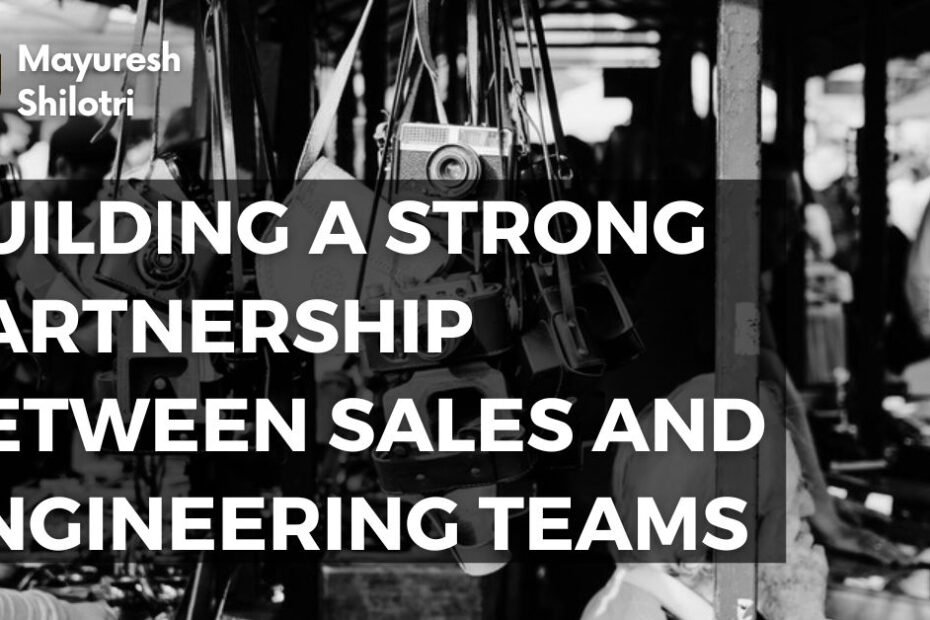In today’s fast-paced business environment, the synergy between sales and engineering teams is more critical than ever. These two departments, while distinct in their functions, share a common goal: to deliver exceptional products and services that meet customer needs. When sales and engineering collaborate effectively, they can create a seamless experience for customers, leading to increased satisfaction and loyalty.
This collaboration not only enhances product development but also ensures that the sales team is well-equipped with the technical knowledge necessary to communicate the value of the product effectively. Moreover, the integration of sales and engineering fosters innovation. When engineers understand market demands and customer feedback, they can design products that are not only technically sound but also aligned with market trends.
Conversely, when sales teams are informed about the technical capabilities and limitations of products, they can set realistic expectations for customers. This mutual understanding can lead to more accurate forecasting, better resource allocation, and ultimately, a stronger competitive edge in the marketplace.
Key Takeaways
- Collaboration between sales and engineering teams is crucial for success
- Each team has distinct roles and responsibilities that should be clearly defined
- Effective communication channels must be established to ensure smooth collaboration
- Clear goals and expectations need to be set to align both teams towards a common objective
- Creating a feedback loop is essential for continuous improvement and growth
Understanding the Roles and Responsibilities of Each Team
Sales Team: Generating Revenue and Building Relationships
The sales team is primarily responsible for generating revenue through customer acquisition and retention. They engage with clients, identify their needs, and present solutions that align with those needs. Their success hinges on their ability to communicate effectively, build relationships, and close deals. They are often the first point of contact for customers and play a crucial role in gathering feedback that can inform product development.
Engineering Team: Focusing on Technical Aspects
The engineering team focuses on the technical aspects of product development. Their responsibilities include designing, building, testing, and maintaining products. Engineers must ensure that products meet quality standards and function as intended. They rely on data and technical specifications to guide their work, often requiring a deep understanding of both the technology involved and the market landscape.
Collaboration and Mutual Appreciation
By recognizing these distinct roles, both teams can appreciate each other’s contributions and work towards a common objective.
Establishing Effective Communication Channels
Effective communication is the backbone of successful collaboration between sales and engineering teams. Establishing clear communication channels can help bridge the gap between these two departments. Regular meetings, whether in-person or virtual, can facilitate open dialogue where both teams can share insights, updates, and challenges.
These meetings should be structured to allow for both teams to present their perspectives, ensuring that everyone has a voice in discussions. In addition to scheduled meetings, utilizing collaborative tools such as project management software or communication platforms can enhance real-time communication. Tools like Slack or Microsoft Teams allow for instant messaging and file sharing, making it easier for team members to ask questions or provide updates without waiting for formal meetings.
By fostering an environment where communication is encouraged and streamlined, both sales and engineering teams can work more cohesively towards shared goals.
Setting Clear Goals and Expectations
Setting clear goals and expectations is vital for aligning the efforts of sales and engineering teams. When both teams understand what is expected of them and how their contributions impact overall objectives, they are more likely to work collaboratively. Goals should be specific, measurable, achievable, relevant, and time-bound (SMART).
For instance, a goal could be to increase product adoption by 20% within six months by leveraging feedback from the sales team to inform engineering decisions. Additionally, it is important to establish shared goals that require collaboration between both teams. For example, if the engineering team is tasked with developing a new feature based on customer feedback gathered by the sales team, both departments should work together to define success metrics for that feature’s launch.
This shared accountability fosters a sense of partnership and encourages both teams to support one another in achieving their objectives.
Creating a Feedback Loop for Continuous Improvement
A robust feedback loop is essential for continuous improvement in any organization. In the context of collaboration between sales and engineering teams, this means creating mechanisms for both teams to provide input on each other’s performance and processes. For instance, after a product launch, the sales team can share customer feedback regarding usability or features that may need enhancement.
This information is invaluable for engineers who are tasked with refining the product. Conversely, engineers can provide insights into product capabilities that may not be fully understood by the sales team. By sharing technical knowledge about what is feasible within certain timelines or budgets, engineers can help sales set realistic expectations with customers.
Regularly scheduled feedback sessions can help institutionalize this process, ensuring that both teams are continuously learning from each other’s experiences and adapting their strategies accordingly.
Aligning Sales and Engineering Strategies
Aligning the strategies of sales and engineering teams is crucial for maximizing efficiency and effectiveness. This alignment begins with a shared understanding of market trends and customer needs. Both teams should collaborate on market research initiatives to gather insights that inform product development as well as sales strategies.
For example, if market research indicates a growing demand for a specific feature, both teams can prioritize its development and promotion. Furthermore, aligning strategies involves coordinating timelines and resources effectively. If the engineering team is working on a new product release, the sales team should be prepared with marketing materials and training to ensure they can effectively sell the product upon launch.
Joint planning sessions can help synchronize efforts and ensure that both teams are working towards common milestones.
Leveraging Technology to Facilitate Collaboration
In an increasingly digital world, leveraging technology can significantly enhance collaboration between sales and engineering teams. Various tools are available that facilitate project management, communication, and data sharing. For instance, using Customer Relationship Management (CRM) systems like Salesforce allows sales teams to track customer interactions while providing engineers with insights into customer preferences and pain points.
Additionally, collaborative platforms such as Confluence or Trello can help both teams manage projects more effectively by providing visibility into ongoing tasks and deadlines. These tools enable real-time updates and foster transparency in workflows, allowing both teams to stay informed about each other’s progress. By embracing technology as an enabler of collaboration, organizations can streamline processes and enhance productivity across departments.
Developing a Mutual Understanding of Customer Needs
A deep understanding of customer needs is fundamental for both sales and engineering teams to succeed. Sales professionals are often on the front lines interacting with customers daily; they gather valuable insights about customer preferences, pain points, and expectations. This information should be communicated effectively to the engineering team so that product development aligns with actual market demands.
Conversely, engineers should also engage with customers when possible to gain firsthand knowledge about how products are used in real-world scenarios. This direct interaction can provide engineers with context that enhances their understanding of customer needs beyond what is captured in surveys or reports. By fostering opportunities for both teams to engage with customers directly or indirectly, organizations can ensure that their products are designed with user experience at the forefront.
Encouraging Cross-Training and Skill Sharing
Cross-training between sales and engineering teams can significantly enhance collaboration by fostering a deeper understanding of each other’s roles. When members of one team receive training on the fundamentals of the other team’s work, they become more empathetic towards each other’s challenges and constraints. For example, engineers who understand basic sales techniques may be better equipped to support their colleagues during client presentations or product demonstrations.
Skill sharing initiatives can also promote collaboration by allowing team members to showcase their expertise in specific areas. For instance, a sales representative could conduct a workshop on effective communication strategies while an engineer could share insights into product design principles. These initiatives not only build camaraderie but also equip team members with diverse skills that enhance overall team performance.
Resolving Conflicts and Finding Common Ground
Conflicts may arise between sales and engineering teams due to differing priorities or perspectives on how best to serve customers. It is essential for organizations to have mechanisms in place for resolving these conflicts constructively. Open dialogue is key; both teams should feel comfortable expressing their concerns while also being willing to listen to each other’s viewpoints.
Finding common ground often involves focusing on shared goals rather than individual departmental objectives. For instance, if there is disagreement over product features due to technical limitations versus market demand, both teams should revisit their ultimate goal: delivering value to customers. By reframing discussions around shared objectives rather than departmental silos, organizations can foster a collaborative culture that prioritizes problem-solving over conflict.
Celebrating Successes and Recognizing Team Contributions
Recognizing achievements is vital for maintaining morale and motivation within collaborative environments. Celebrating successes—whether big or small—can reinforce positive behaviors and encourage continued collaboration between sales and engineering teams. Organizations should establish recognition programs that highlight joint efforts leading to successful product launches or significant sales milestones.
Moreover, acknowledging individual contributions within these collaborative efforts fosters a sense of ownership among team members. When engineers receive recognition for their role in developing a feature that drives sales growth or when sales representatives are celebrated for effectively communicating technical aspects of a product, it reinforces the importance of teamwork in achieving organizational goals. By cultivating a culture of recognition, organizations can strengthen relationships between departments while motivating employees to continue striving for excellence together.
Building a strong partnership between sales and engineering teams is crucial for the success of any organization. In order to achieve this, companies can leverage microlearning and rapid eLearning to enhance the learning culture within their teams. By implementing these innovative learning techniques, teams can stay up-to-date on the latest industry trends and technologies, ultimately leading to improved collaboration and communication between sales and engineering departments. To learn more about how microlearning and rapid eLearning can benefit your organization, check out this insightful article on Shilotri.





